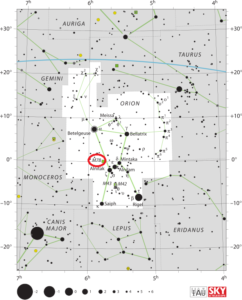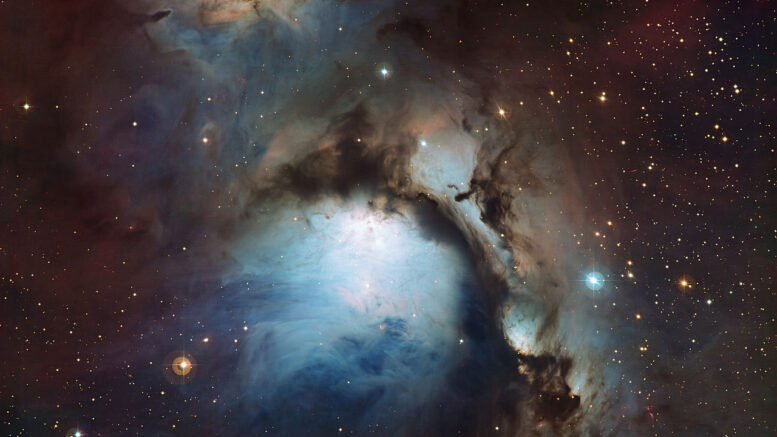Messier 78 or M 78, also known as NGC 2068, is a reflection nebula in the constellation Orion. It was discovered by Pierre Méchain in 1780 and included by Charles Messier in his catalog of comet-like objects that same year.
| Description | |
| Visible From Pacific Northwest | October to February |
| Best Time To Observe | December and January |
| Minimum Size Of Viewing Device | large binoculars |
| Object Type | Reflection Nebula |
| Designations | Messier 78, M78, NGC 2068, Ced 55u |
| Right Ascension | 05h 46.7m |
| Declination | +00°03′ |
| Constellation | Orion |
| Apparent magnitude | +8.3 |
| Apparent dimensions | 8′ x 6′ |
| Object Radius | 5 light years |
| Distance From Earth | 1,600 light years |
History
Messier 78 was discovered by Charles Messier’s colleague Pierre Méchain in early 1780. Messier added the nebula to his catalogue of deep sky objects on December 17 of that year.
John Herschel catalogued the nebula as h 368 and later added it to the General Catalogue as GC 1267. He described it as a “very large wisp-shaped nebula involving 3 stars,” adding that it “extends 5′; terminating abruptly to the north, but extending south-following [SE] beyond the third star.”
Infrared observations of M78 have revealed that at least 192 stars have formed within the molecular cloud associated with the nebula. The cloud is known as Orion B or LDN 1630. The young stars occupy an area of 7 arc minutes of apparent sky.
Locating M78 In The Sky
The nebula is pretty easy to find as it is located only about 2 degrees north and 1.5 degrees east of Alnitak, the easternmost star of Orion’s Belt. Alnitak has two other prominent nebulae associated with it: the Horsehead Nebula and the Flame Nebula. M78 is a bit further away from the star than these two.

Viewing M78
The nebula can easily be seen in large binoculars and small telescopes, which show a hazy, comet-like patch of light with two 10th magnitude stars that illuminate it. M78 is also visible in 10×50 binoculars as a dim patch, but it requires clear, dark skies to be seen.
4-inch telescopes will sometimes reveal the haze around M78 and also show the nearby reflection nebula NGC 2071 under good conditions. 8-inch telescopes begin to show the details of M78. A 9th magnitude open cluster, NGC 2112, can be seen about 1.75 degrees east of the nebula. The cluster lies in the background and is some 2,800 distant. The best time of year to observe M78 is during the winter, when Orion is high in the sky.
Photographing M78
There are some wonderful reviews to help image Messier 78, so that one can utilize some knowledge before checking sites like astrobin and cloudynights. The absolute most important factor in producing a pleasing image of this nebula is time! It is recommended to utilize several hours of exposure time as the dusty details that block out starlight and the produce the beautiful blue glow from behind only emerged after then. Waiting until a new moon is always a good idea, as does great seeing conditions as it will make it easier. Perfect viewing conditions will mean imagers can use a light pollution filter to image M78 from the city. Moreover, there are certain circumstances that a DSLR plus a light pollution filter will be enough.
Sources And Further Reading
Descriptions of all of Messier Objects can be found here.
https://www.nasa.gov/feature/goddard/2018/messier-78/
https://freestarcharts.com/messier-78
https://www.messier.seds.org/m/m078.html

Be the first to comment on "Messier 78"